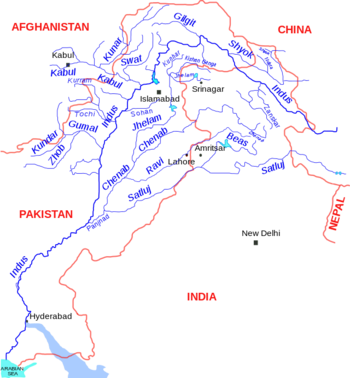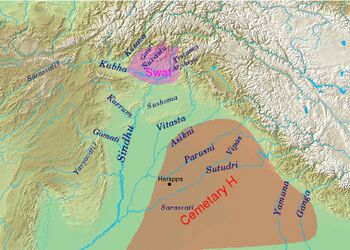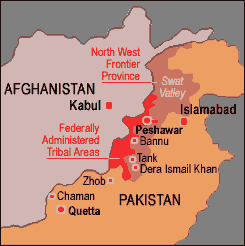Swat
| Author:Laxman Burdak, IFS (Retd.) |

Swat (Hindi:स्वात, Urdu: سوات) is a valley, a River and a district in the Khyber Pakhtunkhwa near the Pakistan-Afghanistan border.
Contents
Variants of name
- Svat River स्वात नदी = Suvastu (सुवास्तु) (AS, p.1004)
- Swat River
- Subhavastu
- Suvastu
- Suat
- Suhoto (Fa-Hian)
- Su-po-fa-su-tu (Xuanzang)
Location
It is the upper valley of the Swat River, which rises in the Hindu Kush range. The capital of Swat is Saidu Sharif, but the main town in the Swat valley is Mingora.
Jat clan
Main Tribes
Main Tribes are Yusufzais, Akhund Khel, Miangan (Syed), Chitralis, Kohistanis, Gurjar (Gujar or Gurjar is the major tribe of the district; its people are divided in different clans including the Khatana, Bajar, Chechi, Ahir, Chauhan, Parmara, Gangal etc. are the main subtribe of the Gurjar family of Swat), Akhund khel Yousafzai, Nooristani, and Awans.
The Dardic people of the Kalam region in northern Swat are known as Kohistanis. They speak the Torwali and Kalami languages. Some Khowar speakers reside in the Kalam region. Before Kalam came under the rule of Swat, it was a regional tributary to Chitral. The Kalamis paid a tribute of mountain ponies to the Mehtar of Chitral every year.
History
V. S. Agrawala[1] writes that Panini mentions ganas headed by Suvastu (Suvāstu) (IV.2.77).
V S Agarwal [2] writes names of some important tribes in the Ganapatha, which deserve to be mentioned as being of considerable importance. We are indebted to the Greek historians of Alexander for the information that most of these were republics. These tribes include - Hāstināyana, Āśvāyana, Āśvakāyana. The first is mentioned in Sutra VI.4.174, the second in IV.1.110, and the third in Naḍadi gana (IV.1.99)
[p.454]: While describing Alexander’s campaign from Kapisa towards the Indus through Gandhara, the Greek historians mention three warlike peoples, viz., Astakenoi, with capital at Peukelaotis, the Aspasioi in the valley of Kunar or Chitral River and the Assakenoi settled between the Swat and the Panjkora rivers, with the capital at Massaga, and more especially in the mountainous regions of the Swat. The Paninian evidence throws light on these three names for the first time:
- (a) Aspasioi = Ashvayana; in Alisang or Kunar Valley
- (b) Assakenoi = Ashvakayana; in the Swat valley and highlands, with capital at Mashakavati
- (c) Astakenoi = Hastinayana; near the confluence of Swat with the the Kabul, with capital at Pushkalavati.
The Asvayanas and the Asvakayanas were the bravest fighters of all, being strongly entrenched in their mountainous fortresses. Alexander himself directed the operations against them. The Ashvakayana capital at Massaga or Masakavati is given in Bhashya as the name of a river (IV.2.71), that should be looked for in that portion of the Suvastu in its lower reaches where Mazaga or Massanagar is situated on it at a distance of 24 miles from Bajaur in the Yusufzai country. In times of danger the Asvakayanas withdrew into the impregnable defences of their hilly fortress which the Greeks have named Aornos. It appears to be same as Varaṇā of the Ashtadhyayi (see ante, p.69, for its identification with modern Uṇrā on the Indus). The Greeks also mention another of their towns, viz., Arigaeon, which commanded the road between the Kunar and Panjkira valleys, and is comparable with Ārjunāva of the Kashika (ṛijunāvām nivāso deshaḥ, IV.2.69).
Swat has been inhabited for over two thousand years. The first occupants created well-planned towns. In 327 BC, Alexander the Great fought his way to Udegram and Barikot and stormed their battlements. In Greek accounts, these towns have been identified as Ora and Bazira, respectively. Around the 2nd century BC, the area was occupied by Buddhists, who were attracted by the peace and serenity of the land. There are many remains that testify to their skills as sculptors and architects.
In the beginning of the 8th century AD, the Gabari Swati Pashtun tribe advanced through Laghmanat, Nangarhar, and Dir. By the early 13th century, they captured Swat, defeating the local Buddhists and the Hindus. This war was headed by Sultan Pakhal Gabari and later on by the Jahangiri Sultan Behram Gabari rulers of Kunar Pech and cousins of the rulers of Kashmir.
Later some Dilazak encroached on the area and settled among the Gabari. They were ousted in turn by the Yusufzais, backed by the Mughal Badshah Zahiruddin Muhammad Baber, considered the super power in 1519 and 1520. The historical paradox was that the Yusufzais were ousted from Kabul by Mirza Ullegh beg, the uncle of Baber, who killed 600 malak of Yusufzai. Yousofzais refugees settled among the Gabaris in the Dir and Swat regions.
With the help of Zahiruddin Muhammad Babur, the Yousofzais encroached upon the Gabari state. They demolished the Gabar-Kot (fortress) in Bajour in 1519 and advanced to the Swat. The last Gabari king, Sultan Awais Gabari, fled to Upper Dir, where he established his rule in Chitral, Wakhan, Badakhshan and other towns along the upper Oxus River.
Ancient Gandhara, the valley of Pekhawar, with the adjacent hilly regions of Swat and Buner, Dir and Bajaur was one of the earliest centers of Buddhist religion and culture following the reign of the Mauryan emperor Ashoka, in the third century BC. The name Gandhara first occurs in the Rigveda, which is usually identified with the region.[3]
The Swat museum has footprints of the Buddha, which were originally placed for devotion in the sacred Swat valley. When the Buddha ascended, relics (personal items, body parts, ashes etc.) were distributed to seven kings, who built stupas over them for veneration. The Harmarajika stupa at Taxila and Butkarha (Swat) stupa at Jamal Garha were among the earliest Gandhara stupas. These were erected on the orders of King Ashoka and contained the genuine relics of the historic Buddha.
स्वात नदी
स्वात = सुवास्तु (AS, p.1004): सिंधु नदी (सिंध पाकिस्तान) में पश्चिम की ओर से मिलने वाली उपनदी [p.1005]: जिस का वैदिक नाम सुवास्तु है. सुवास्तु का अर्थ है सुंदर वास्तु या भवनों से अलंकृत तटप्रदेश वाली नदी हो सकता है. सुवास्तु को ग्रीक लेखक एरियन ने सोयस्टस (Soastus) कहा है. स्वात में काबुल (वैदिक कालीन कुभा) नदी मिलती है. संगम पर रामायण कालीन पुष्कलावती नामक नगरी बसी हुई थी. [4]
2. स्वात या सुवास्त नदी का तटवर्ती देश जिसे सातवीं सदी में चीनी यात्री ह्वेनसांग ने उद्यान नाम से अभिहित किया है. स्वात की काली मिट्टी से गंधार कला की अधिकांश मुखिया निर्मित हुई थी. पेशावर संग्रहालय में इनका अच्छा संग्रह है. [5]
Visit by Fahian
James Legge[6] writes: In that country also Buddhism1 is flourishing. There is in it the place where Sakra,2 Ruler of Devas, in a former age,3 tried the Bodhisattva, by producing4 a hawk (in pursuit of a) dove, when (the Bodhisattva) cut off a piece of his own flesh, and (with it) ransomed the dove. After Buddha had attained to perfect wisdom,5 and in travelling about with his disciples (arrived at this spot), he informed them that this was the place where he ransomed the dove with a piece of his own flesh. In this way the people of the country became aware of the fact, and on the spot reared a tope, adorned with layers6 of gold and silver plates.
1 Buddhism stands for the two Chinese characters {.} {.}, “the Law of Buddha,” and to that rendering of the phrase, which is of frequent occurrence, I will in general adhere. Buddhism is not an adequate rendering of them any more than Christianity would be of {to euaggelion Xristou}. The Fa or Law is the equivalent of dharma comprehending all in the first Basket of the Buddhist teaching — as Dr. Davids says (Hibbert Lectures, p. 44), “its ethics and philosophy, and its system of self-culture;” with the theory of karma, it seems to me, especially underlying it. It has been pointed out (Cunningham’s “Bhilsa Topes,” p. 102) that dharma is the keystone of all king Priyadarsi or Asoka’s edicts. The whole of them are dedicated to the attainment of one object, “the advancement of dharma, or of the Law of Buddha.” His native Chinese afforded no better character than {.} or Law, by which our author could express concisely his idea of the Buddhistic system, as “a law of life,” a directory or system of Rules, by which men could attain to the consummation of their being.
2 Sakra is a common name for the Brahmanic Indra, adopted by Buddhism into the circle of its own great adherents; — it has been said, “because of his popularity.” He is generally styled, as here, T’een Ti, “God or Ruler of Devas.” He is now the representative of the secular power, the valiant protector of the Buddhist body, but is looked upon as inferior to Sakyamuni, and every Buddhist saint. He appears several times in Fa-hien’s narrative. E. H., pp. 108 and 46.
3 The Chinese character is {.}, “formerly,” and is often, as in the first sentence of the narrative, simply equivalent to that adverb. At other times it means, as here, “in a former age,” some pre-existent state in the time of a former birth. The incident related is “a Jataka story.”
4 It occurs at once to the translator to render the characters {.} {.} by “changed himself to.” Such is often their meaning in the sequel, but their use in chapter xxiv may be considered as a crucial test of the meaning which I have given them here.
5 That is, had become Buddha, or completed his course {.} {.}.
6 This seems to be the contribution of {.} (or {.}), to the force of the binomial {.} {.}, which is continually occurring.
Visit by Xuanzang in 631 AD
Alexander Cunningham[7] writes about 7. Udyana or Swat:
[p.81]: On leaving Utakhanda Hwen Thsang travelled about 600 li, or 100 miles, towards the north, to U-chang-na, or Udyana, which was situated on the river Su-po-fa-su-tu, the Subhavastu and Suvastu of Sanskrit, the Suastus of Arrian, and the Swat or Suat river of the present day. It is called U-chang by the earlier pilgrims Fa-Hian and Sung-yun, which is a close transcript of Ujjana, the Pali form of Udyana. The country is described as highly irrigated, and very fertile. This agrees with all the native accounts, according to which Swat is second only to the far-famed valley of Kashmir. Hwen Thsang makes it 5000 li, or 833 miles, in circuit, which must be very near the truth, if, as was most probably the case, it included all the tributaries of the Swat river. Udyana would thus have embraced the four modern districts of Panjkora, Bijawar, Swat, and Bunir, which have a circuit of only 500 miles, if measured on the map direct, but
[p.82]: of not less than 800 miles by road measurement. Fa-Hian mentions Su-ho-to as a small district to the south of Udyana. This has generally been identified with the name of Swat ; but from its position to the south of Udyana, and to the north of Parashawar, it cannot have been the large valley of the Swat river itself, but must have been limited to the smaller valley of Bunir. This is confirmed by the legend told by Fa-Hian of the hawk and pigeon ; in which Buddha, to save the pigeon, tears his own flesh and offers it to the hawk. The very same legend is related by Hwen Thsang, but he places the scene at the north-west foot of the Mahaban mountain, that is, in the actual valley of Bunir. He adds that Buddha was then a king, named Shi-pi-kia, or Sivika, which may, perhaps, be the true form of Fa-Hian's Suhoto.
The capital of Udyana was called Mung-kie-li, or Mangala, which is probably the Mangora of Wilford's surveyor, Mogal Beg, and the Manglora of General Court's map. It was 16 or 17 li, about 2¾ miles, in circuit, and very populous. At 250 or 260 li, about 42 miles, to the north-east of the capital the pilgrim reached the source of the Subhavastu river, in the fountain of the Naga king Apalāla ; and at 750 li, or 125 miles, further in the same direction, after crossing a mountain range and ascending the Indus, he arrived at Tha-li-lo, or Darel, which had been the ancient capital of Udyana. Darel is a valley on the right or western bank of the Indus, now occupied by Dardus, or Dards, from whom it received its name. It is called To-li by Fa-Hian, who makes it a separate kingdom. The Dards are now usually divided into three separate tribes, according to the dialects which
[p.83]: they speak. Those who use the Arniya dialect occupy the north-western districts of Yasan and Chitral ; those who speak the Khajunah dialect occupy the north-east districts of Hunza and Nager ; and those who speak the Shina dialect occupy the valleys of Gilgit, Chilas, Darel, Kohli, and Palas, along the banks of the Indus. In this district there was a celebrated wooden statue of the future Buddha Maitreya, which is mentioned by both of the pilgrims. According to Fa-Hian it was erected 300 years after the Nirvana of Buddha, or about B.C. 243, that is, in the reign of Asoka, when the Buddhist religion was actively disseminated over India by missionaries. Hwen Thsang describes the statue as 100 feet in height, and states that it was erected by Madhyantika.[8] The name and the date mutually support each other, as Madhyantika, or Majjhima in Pali, was the name of the Buddhist teacher, who, after the assembly of the Third Synod in Asoka's reign, was sent to spread the Buddhist faith in Kashmir and the whole Himavanta country.[9] This is most probably the period alluded to by Hwen Thsang when Darel was the capital of Udyana.
External links
References
- ↑ India as Known to Panini, p.74
- ↑ V S Agarwal, India as Known to Panini,p.453-454
- ↑ F. A. Khan, Architecture and Art Treasures in Pakistan, Elite Publishers, 1969
- ↑ Aitihasik Sthanavali by Vijayendra Kumar Mathur, p.1004
- ↑ Aitihasik Sthanavali by Vijayendra Kumar Mathur, p.1005
- ↑ A Record of Buddhistic Kingdoms/Chapter 9
- ↑ The Ancient Geography of India/Udyana, pp. 81-83
- ↑ Julien's ' Hiouen Thsang,' ii. 168. But he fixes the date at only 50 years after Buddha, for which we should most probably read 250 years.
- ↑ Tumour's ' Mahawanso,' p. 71 ; see also my ' Bhilsa Topes,' p. 120.

